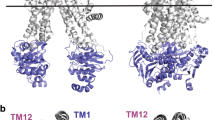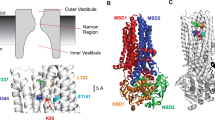Abstract
Most ATP-binding cassette (ABC) proteins function as ATP-dependent membrane pumps. One exception is the cystic fibrosis transmembrane conductance regulator (CFTR), an ABC protein that functions as a Cl− ion channel. As such, the CFTR protein must form a continuous pathway for the movement of Cl− ions from the cytoplasm to the extracellular solution when in its open channel state. Extensive functional investigations have characterized most parts of this Cl− permeation pathway. However, one region remains unexplored—the pathway connecting the cytoplasm to the membrane-spanning pore. We used patch clamp recording and extensive substituted cysteine accessibility mutagenesis to identify amino acid side-chains in cytoplasmic regions of CFTR that lie close to the pathway taken by Cl− ions as they pass from the cytoplasm through this pathway. Our results suggest that Cl− ions enter the permeation pathway via a single lateral tunnel formed by the cytoplasmic parts of the protein, and then follow a fairly direct central pathway towards the membrane-spanning parts of the protein. However, this pathway is not lined continuously by any particular part of the protein; instead, the contributions of different cytoplasmic regions of the protein appear to change as the permeation pathway approaches the membrane, which appears to reflect the ways in which different cytoplasmic regions of the protein are oriented towards its central axis. Our results allow us to define for the first time the complete Cl− permeation pathway in CFTR, from the cytoplasm to the extracellular solution.






Similar content being viewed by others
Abbreviations
- ABC:
-
ATP-binding cassette
- CFTR:
-
Cystic fibrosis transmembrane conductance regulator
- ECL:
-
Extracellular loop
- ICL:
-
Intracellular loop
- MSD:
-
Membrane-spanning domain
- MTSES:
-
[2-sulfonatoethyl] methanethiosulfonate
- NBD:
-
Nucleotide binding domain
- RD:
-
Regulatory domain
- SCAM:
-
Substituted cysteine accessibility mutagenesis
- TM:
-
Transmembrane α-helix
References
Wang Y, Wrennall JA, Cai Z, Li H, Sheppard DN (2014) Understanding how cystic fibrosis mutations disrupt CFTR function: from single molecules to animal models. Int J Biochem Cell Biol 52:47–57
Dean M, Rzhetsky A, Alikmets R (2001) The human ATP-binding cassette (ABC) transporter superfamily. Genome Res 11:1156–1166
Chen T-Y, Hwang T-C (2008) CLC-0 and CFTR: chloride channels evolved from transporters. Physiol Rev 88:351–387
Jordan IK, Kota KC, Cui G, Thompson CH, McCarty NA (2008) Evolutionary and functional divergence between the cystic fibrosis transmembrane conductance regulator and related ATP-binding cassette transporters. Proc Natl Acad Sci USA 105:18865–18870
Hunt JF, Wang C, Ford RC (2013) Cystic fibrosis transmembrane conductance regulator (ABCC7) structure. Cold Spring Harb Perspect Med 3:a009514
Hwang T-C, Kirk KL (2013) The CFTR ion channel: gating, regulation, and anion permeation. Cold Spring Harb Perspect Med 3:a009498
Linsdell P (2014) Functional architecture of the CFTR chloride channel. Mol Membr Biol 31:1–16
Gadsby DC (2009) Ion channels versus ion pumps: the principal difference, in principle. Nat Rev Mol Cell Biol 10:344–352
El Hiani Y, Linsdell P (2014) Conformational changes opening and closing the CFTR chloride channel: insights from cysteine scanning mutagenesis. Biochem Cell Biol 92:481–488
Mornon J-P, Hoffmann B, Jonic S, Lehn P, Callebaut I (2015) Full-open and closed CFTR channels, with lateral tunnels from the cytoplasm and an alternative position of the F508 region, as revealed by molecular dynamics. Cell Mol Life Sci 72:1377–1403
Corradi V, Vergani P, Tieleman DP (2015) Cystic fibrosis transmembrane conductance regulator (CFTR): closed and open state channel models. J Biol Chem 290:22891–22906
Akabas MH (1998) Channel-lining residues in the M3 membrane-spanning segment of the cystic fibrosis transmembrane conductance regulator. Biochemistry 37:12233–12240
Ge N, Muise CN, Gong X, Linsdell P (2004) Direct comparison of the functional roles played by different transmembrane regions in the cystic fibrosis transmembrane conductance regulator chloride channel pore. J Biol Chem 279:55283–55289
Norimatsu Y, Ivetac A, Alexander C, Kirkham J, O’Donnell N, Dawson DC, Sansom MS (2012) Cystic fibrosis transmembrane conductance regulator: a molecular model defines the architecture of the anion conduction path and locates a “bottleneck” in the pore. Biochemistry 51:2199–2212
Zhang J, Hwang T-C (2015) The fifth transmembrane segment of cystic fibrosis transmembrane conductance regulator contributes to its anion permeation pathway. Biochemistry 54:3839–3850
El Hiani Y, Linsdell P (2015) Functional architecture of the cytoplasmic entrance to the cystic fibrosis transmembrane conductance regulator chloride channel pore. J Biol Chem 290:15855–15865
Mense M, Vergani P, White DM, Altberg G, Nairn AC, Gadsby DC (2006) In vivo phosphorylation of CFTR promotes formation of a nucleotide-binding domain heterodimer. EMBO J 25:4728–4739
Li M-S, Demsey AFA, Qi J, Linsdell P (2009) Cysteine-independent inhibition of the CFTR chloride channel by the cysteine-reactive reagent sodium (2-sulphonatoethyl) methanethiosulphonate. Br J Pharmacol 157:1065–1071
Holstead RG, Li M-S, Linsdell P (2011) Functional differences in pore properties between wild-type and cysteine-less forms of the CFTR chloride channel. J Membr Biol 243:15–23
El Hiani Y, Linsdell P (2010) Changes in accessibility of cytoplasmic substances to the pore associated with activation of the cystic fibrosis transmembrane conductance regulator chloride channel. J Biol Chem 285:32126–32140
Bai Y, Li M, Hwang T-C (2010) Dual roles of the sixth transmembrane segment of the CFTR chloride channel in gating and permeation. J Gen Physiol 136:293–309
Wang W, El Hiani Y, Linsdell P (2011) Alignment of transmembrane regions in the cystic fibrosis transmembrane conductance regulator chloride channel pore. J Gen Physiol 138:165–178
Qian F, El Hiani Y, Linsdell P (2011) Functional arrangement of the 12th transmembrane region in the CFTR chloride channel based on functional investigation of a cysteine-less variant. Pflügers Arch 462:559–571
Wang W, El Hiani Y, Rubaiy HN, Linsdell P (2014) Relative contribution of different transmembrane segments to the CFTR chloride channel pore. Pflügers Arch 466:477–490
El Hiani Y, Linsdell P (2012) Role of the juxtamembrane region of cytoplasmic loop 3 in the gating and conductance of the cystic fibrosis transmembrane conductance regulator chloride channel. Biochemistry 51:3971–3981
Bai Y, Li M, Hwang T-C (2011) Structural basis for the channel function of a degraded ABC transporter, CFTR (ABCC7). J Gen Physiol 138:495–507
Gao X, Bai Y, Hwang T-C (2013) Cysteine scanning of CFTR’s first transmembrane segment reveals its plausible roles in gating and permeation. Biophys J 104:786–797
Acknowledgments
We would like to thank Christina Irving for technical assistance. This work was supported by the Canadian Institutes of Health Research.
Author information
Authors and Affiliations
Corresponding author
Rights and permissions
About this article
Cite this article
El Hiani, Y., Negoda, A. & Linsdell, P. Cytoplasmic pathway followed by chloride ions to enter the CFTR channel pore. Cell. Mol. Life Sci. 73, 1917–1925 (2016). https://doi.org/10.1007/s00018-015-2113-x
Received:
Revised:
Accepted:
Published:
Issue Date:
DOI: https://doi.org/10.1007/s00018-015-2113-x




